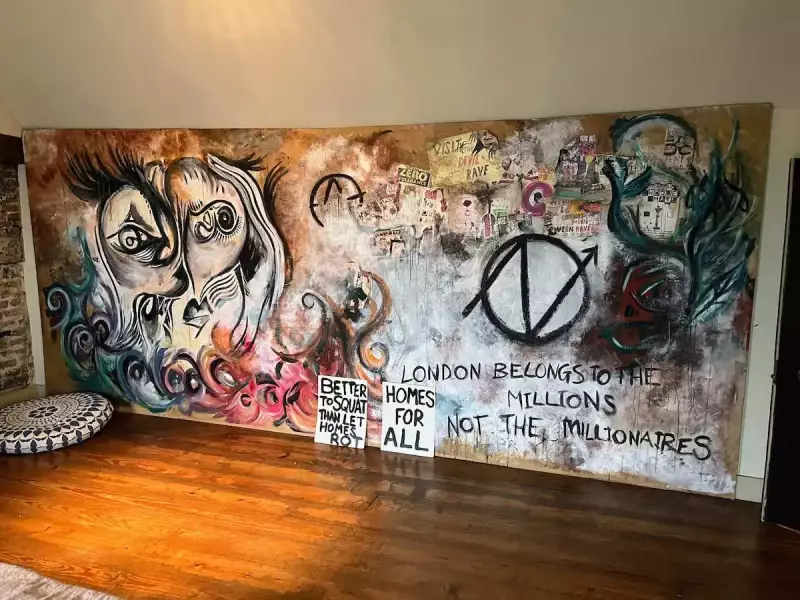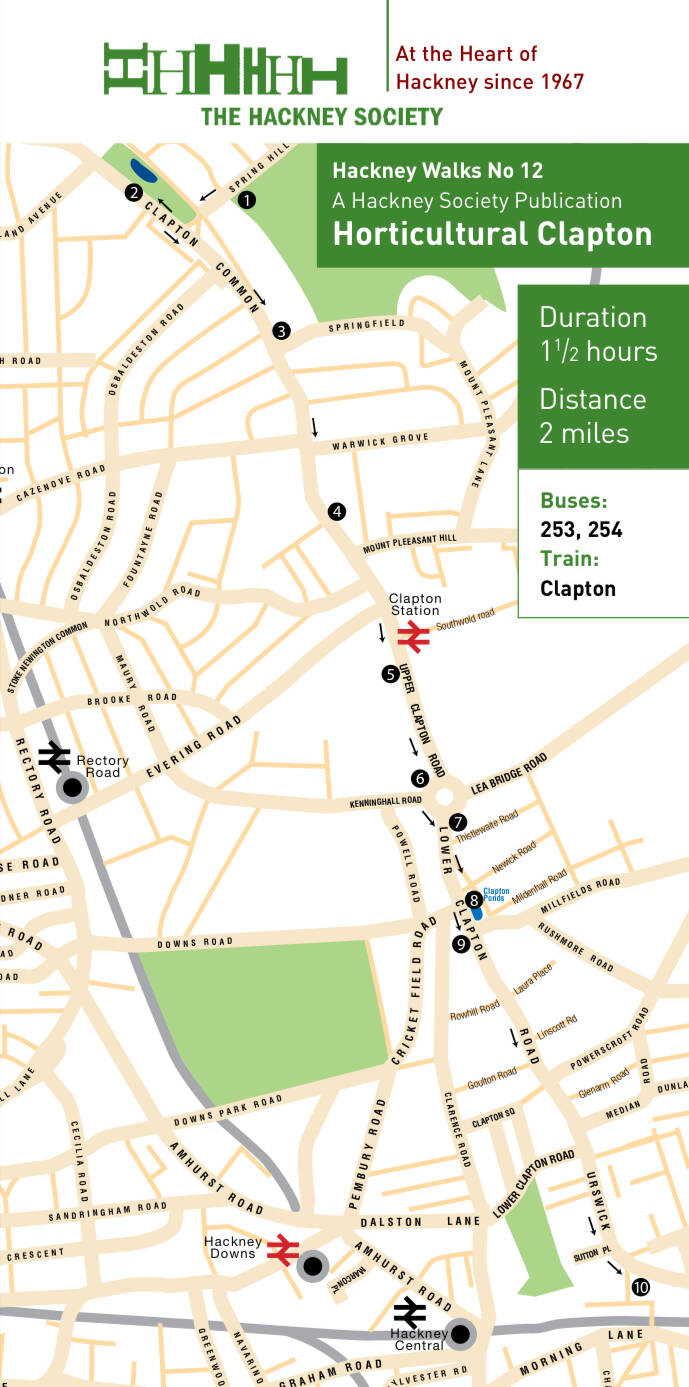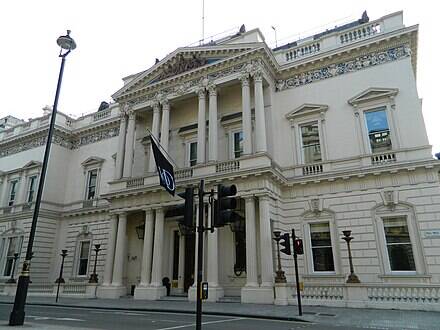8. From VICTORIA PARK and VILLAGE to HOMERTON and HACKNEY
Content

You are about to start reading the First of the two parts
LANDMARKS
—VICTORIA PARK VILLAGE. Shops and Eateries. Victorian. FRENCH (HUGUENOT) HOSPITAL. KNIGHTS HOSPITALERS
—HOMERTON WELL STREET MARKET. Shops and eateries
The FIRST Mr.COhen’ stall (a future TesCO!)
Second Part
—HACKNEY CENTRAL
Hackney Designer hub: Luxury Shopping
SUTTON HOUSE . The oldest house in East London SUTTON PLACE. Georgian ST.JOHN’s Church & ST.AGUSTINE’s, the old one
MARE STREET. The civic centre: Hackney Empire, Town Hall, Local museum. Shops and eateries
—LOWER CLAPTON
—CLAPTON PARK. Victorian neighbourhood CHATSWORTH ROAD MARKET. Shops and eateries Banks of the LEA NAVIGATION
VICTORIA PARK, HOMERTON, HACKNEY, LOWER CLAPTON, CLAPTON PARK, RIVER LEA VALLEY
On the map, I pointed out ST.AGUSTINE’S TOWER, only surviving part of the old HACKNEY church
Hackney Marshes lie between the natural course of the RIVER LEA and the LEE NAVIGATION
After VICTORIA PARK… the VILLAGE. Well, in fact, you are in HOMERTON
You are in Lauriston Road, pointed on the map


Have a look at the chapter dedicated to VICTORIA PARK and VILLAGE of VISIT LONDON’S EAST END, as long as the PARK is concerned. The PARK is part of TOWER HAMLETS. Now, once in the VILLAGE you are in SOUTH HACKNEY.
The village is not a real, old village. Not one of those Anglo-Saxon villages which had been absorbed to the metropolis. In 1672 barely 16 properties were assessed for HEARTH TAX (MONGER and MORRIS among them). In 1770 there were still a few buildings, one of them the THREE COLTS INN. The JEWISH BURIAL GROUND dates from 1788. More cottages had been build by 1821: 38 households. VICTORIA PARK ROAD was a footpath.
Here, the landowners saw the chance to make a fortune, converting fields into residential, once the park had been created. 30.000 people had signed a petition presented to QUEEN VICTORIA and the government, requesting a open green space for the “healthful recreation” of the working classes of the burgeoning EAST END. The government made an effort and sold YORK HOUSE in WESTMINSTER to raise funds, and finally the Queen opened the park in 1846.
Along LAURISTON RD. The first building you will come across, once you exit the PARK through the ROYAL GATE is
THE ROYAL INN THE PARK PH, that is the former ROYAL HOTEL
Free-standing fine mid-Victorian , imitating an Italian PALAZZO, with the piano nobile behind the Western façade, a Palladian effect. Elegant and dignified gatehouse to the park.
The scene of the killing of JAMES MOODY, in 1993. But that was long after this area became the KRAYS-RICHARDSONS GANGLAND…
The JEWISH BURIAL GROUND
Opened in 1788, closed in 1886. A small SEPHARDIC Jewish community had grown up in Hackney, by early 18thc. In 1786 a group of ASHKENAZIM, on behalf of the HAMBRO SYNAGOGUE, purchased land in order to establish a burial ground. And by 1865 thearea around was all built up.
By mid century, the cemetery had been somewhat rundown, but Mrs.FLATOU, in memory of her husband Victor, paid for some improvements in 1870.
JEWISH CHRONICLE reported them: rebuilding the MORTUARY HALL, repairing the walls, the iron railings and the gates, opening of new paths, planting of trees, removal of some tombs…
Previous to the closure, the PRAYER HALL was demolished.
The LODGE is a miniature Victorian villa, with a projecting gable, framed in plaster, supported by numerous corbels. The diminutive porch is really charming.
HEADSTONES and CHEST-TOMBS an be seen.
There have been recent plans to built a wooden synagogue on the site.w.jewish herir.
Exceptionally , when the ground keeper died, in 2002,he was permitted to be buried here.
LAURISTON ROAD STRIPS
Those raised beds with mature plane trees and grass, are protected. The Hackney District Board created 5hem
SCHOOL
Built by the LCC in 1910, as a LAURISTON (later HACKNEY) CENTRAL SCHOOL, for 340 kids. A CENTRAL school was established to educate brighter children, whose families could not afford fees, and who had not won a scholarship. Their aim was not passing examinations, but give them a general, education, with emphasis in the acquisition of commercial skills (shorthand, typing, bookkeeping…) or as they said bac then to put boys and girls on the road that they could travel best.
The school moved out in 1917, but it was established here again, occupying the 1891 building next door. The 1910 building became the LAURISTON PRIMARY SCH. until the 1970s.
The TRINITY CONGREGATIONAL CHURCH
1901. Arch.P MORLEY HORDER, in a mixed late Gothic and Arts & Craft.
LAURISTON ROAD
Start feeling the unique village atmosphere of the place. First called GROVE ROAD, afterwards known as THE BROADWAY, it became filled with greengrocers, bakers and butchers, and other shops of the kind… and a couple of pubs. You can see a 1930s style café, MARINOS. The cake shop used to be SHEPHARDS BAKERY. A traditional Victorian prosperous suburb…
AH DAVIS’ HARDWARE STORE was a typical 1930s shop, where everything got dusted off as it was taken from the shelf. A trap door used to lead to the cellar… Part of this interior was transferred to BLACKHEATH AGE EXCHANGE (reminiscence workshops).
The tram stables have been converted. At one stage, in the East side one, CAROLINE BUSFIELD GREGORY had his pottery workshop. Now she is in HERTFORDSHIRE, and in the place of her workshop you will fi d a giftshop. However, on the same site, from the 1920s, valve radios were repaired and light bulb sold. When the electrician retired and transferred the property to Caroline he left an old silver 6 pence nailed to the inside of the till drawer, to bring her luck!.
Now on the side of those old shops you will find designer boutiques, gift shops, interior designers, hair & beauty salons, and different types of eateries.
Mind you, by 1894 there were some leather factories around WELL ST. Industry though was limited by building covenants.
From 1855, East of the COMMON, a new road was laid out for building, as a freehold estate, by the SUBURBAN VILLA AND VILLAGE ASSOCIATION, aimed at the lower-middle classes.
The CHARLES BOOTH’s 1890s POVERTY SURVEY, shows how most of the streets were well to do, but some only fairly confortable.
To the N of the PARK, the CASS and the NORRIS ESTATES never developed a the potentially prosperous areas as they were thought off in the beginning. Building plans were delayed and, eventually, scaled down due to lack of funding and building better approach roads by the CROWN COMMISSIONERS. The development became more sporadic, , took longer, and became less uniform in design. The was, in fact, an overall estate plan, but a number of individual buildings.
In 1881 the SUBURBAN HOMES OF LONDON.A RESIDENTIAL GUIDE advertised larg and handsome houses at £75-100/per annum, smaller but convenient ones at £45-75, and smaller residences les than £45/per annum. These different types attracted the middle classes, especially City employees
MEYNELL ROAD was not b. in 1894.
At the turn of the century this was a well-to-do, smart area. A district had a piano shop, and a home where women went to give birth.
However, less rosy times were on the way. Turf war in our streets were brought when the area became something of an overspill from the KRAY TWINS’ organised crime network.
The ALEXANDRA was a drug pub for a time. The site of the THD EMPRESS OF INDIA was at one point a real dodgy dive. The result was decline, families leaving, businesses closing down…
Early 21th locals took matters into their hands, forming the VICTORIA PARK TRADERS ASSOCIATION. They have achieved a lot: new shops and eateries opened, covering a full range, being ran by their owners, thus creating that community atmosphere, that you are now enjoying.
Definitely a chichi area, that has attracted some very prosperous neighbours, as professionals working in CANARY WHARF.
LAURISTON. WHO WAS Mr.LAURISTON?.
I have always been intrigued by this name. Is it a coincidence that this is the name of the street in PARIS where the French branch of the NAZI GESTAPO had its HQ during France’s occupation of 1940-44?.
Probably not, as JACQUES ALEXANDER LAW DE LAURISTON, French diplomat, military and statesman, whose father was a nephew of SCOTTISH-FRENCH banker and economist JOHN LAW, CONTRÔLEUR GÉNÉRAL DE FINANCES DU ROYAUME DE FRANCE, in 1720.
If you walk alongside WETHERELL ROAD…
THE TABERNACLE
Think about JOSIAH HENSON, addressing, here , in 1876, a bursting congregation of 2.000. He was from MARYLAND, into slavery, and was sold 3 times before he was 18. But he succeeded to escape, before becoming and author and and activist for abolition.
And a moving talk by HENRY FAWCETT MP, who gave here, in 1884, his annual address to 150 of London’s blind poor. He, who had lost his sight at 25, in a shooting accident, spoke with great optimism, at was cheered at several intervals. “We who are blind have many advantages”, he said. “To no classify who requires friendly and generous aid is that aid more cheerfully and generously given”.
Here, though, and around the same time, a serious disturbance caused by an anti-Catholic lecture of dubious character, prompted SIR JAMES SEXTON MP to ask for measures to stop it happening again. The government replied than they had no power to prevent people from lecturing either for or again Protestantism.
No.45 Site of THE BEDFORD HOTEL
Arch. THOMAS ENNOR. A mid-Victorian building in a commanding position. Large staggered quoins.
Admire the fenestration, the Corinthian columns, the string course.
Entablature with strongly projecting cornice, console brackets.
Impressive portico entrances (2 of them closed-off).
Lion head brackets, very exaggerated. Bursting fruit swags
GUINNES TRUST REDEVELOPMENT (1970s)
The area had been badly damaged during WW2
After this district, you could heading to BROADWAY MARKET and LONDON FIELDS (see below), or straight to HACKNEY (see below) , or to HACKNEY WICK, FISH ISLAND and the OLYMPIC PARK (VLEE).
However, you have more choice… What about HOMERTON?.
Site of The FRENCH HOSPITAL. The HUGUENOTS
F. In 1718 in FINSBURY, as LA PROVIDENCE, in order to take care of infirm HUGUENOTS, or those who had fallen in financial dire straits
Protestant cult was banned in France, by LOUIS XIV, from 1685. See VISIT LONDON’S EAST END ( (SPITALFIELDS chapter) for more about the subject.
C.50.000 people took shelter in GREAT BRITAIN: the French called it LE REFUGE (and the word entered the English language). As the financial situation of the newly arrived was precarious, this led to an explosion of generosity on the part of the British, but as well, amongst the French.
In London, the refugees settled in SHOREDITCH and SPITALFIELDS, and in order to provide them with medical care, they opened a DISPENSARY, N of OLD ST, in an old LAZARET, abandoned since 1693.
WILLIAM & MARY’s GRAND VENEUR, JACQUES DE GASTIGNY legated £100 to improve the establishment, so it was in condition to receive the poor and infirm, giving them roof an sustain. The executor was PHILIPPE MENARD, and he launched an appeal to augment the legate so successful that a new building was made possible, on a site next to the old lazaret, in BATH STREET. This was the first health and welfare institution in GB sustained by voluntary contributions, following a tradition already rooted in France.
That new building, Georgian in style of course, erected inn1718, was designed by JACOB GIBBS, to receive 80 patients. In 1760, new buildings were added (234 patients), and the mentally infirm were, for the first time in the country, were properly treated.
Royal Patent was received in 1718, including a coat of arms (ELIE fed by the ravens) and a motto (DOMINUS PROVIDEBIT). Now we understand: LA PROVIDENCE.
By the beginning of the 19th c. the institution was in decline. The French were melting within British society, and living far away from their ancestral districts. On the other hand, the building was in need of renovation, and at the same time the green, rural, healthy setting of the area around had disappeared. The decision was taken to find a new location.
The new place was HACKNEY!. It was designed by ROBERT LOUIS ROUMIEU, in a 16th c. French style, including a chapel. ROUMIEU, by the way, renounced his fees, and he became the Treasurer.
Opened in 1866, the equipment here was modern, le dernier cri, and for up to 60 residents . The place became as well a repository for HUGUENOT ARCHIVES and historical objects related to the community.
The residents were well known by the neighbours, being encoraged to make themselves useful. 12 women WEAVERS were busy, in 1887, making a black silk dress, for QUEEN V, to mark her GOLDEN JUBILEE.
In 1941, the hospital was requisitioned and the resident Huguenots were evacuated in order to provide a nursery for children.
After the War, the administrators decided to reorient the activities towards a hospice function.
In 1947, it was transferred to HORSHAM. In 1959 It moved to ROCHESTER
North of the former FRENCH HOSPITAL (now, a school )
Towards the N of the present SCHOOL
25 PENHURST RD. THE PENHURST ARMS PH
An 1864 typical estate pub, contemporary of the development. On a street corner, with round columns, flanked with vermiculated quoins. The name, on the prominent curved pediment.
Windows with fine curved cornices, vermiculated keystones, and supported by console brackets.
The upper floor windows are plainer, with depressed arches and less prominent keystones.
HOSPITAL ESTATE mark
If you walk again, Northwards, LAURISTON ROAD
CHURCH CRESCENT
1981-84 Two pairs of SEMI-DETACHED VILLAS
By arch. COLQUHON and MILLER. Distinct for overhanging eaves, influenced by PALLADIANISM ant RENNIE MACKINTOSH.
Postmodernism
Modernism: cubes of concrete. BAUHAUS influence is seen in windows directly cut into concrete, and a tall central window, to lit the internal staircase.
Art & Craft: port hole windows and details of the fenestration of the internal stairs.
LE CORBUSSIER: geometrical elements and balconies.
Built, as social housing, forlarge families
ST.JOHN OF JERUSALEM CHURCH
The original stone spire was destroyed by a V1 towards the end of WW2. Curiously enough, especially during the BLITZ, it was used as a landmark by the LUFTWAFFE, on their flight path into London on bombing raids.
The present copper spire was lowered down to place by helicopter.
This church was not only one of the first buildings of the new development (1845-48), but it also succeeded a previous, Classical, ST.JOHN’s, b. 1810.
In Early English Gothic Revival, it was designed by Arch.EDWARD CLARKES HAKEWILL. His was, as well, ST.AGUSTINE’s VICTORIA PARK. And, as well, his West front model of RHEIMS CATH. is now in the V&A.
The first rector was HENRY HADLEY NORRIS, who was a significant figure in the foundation of the NATIONAL SOCIETY, which, to this day, continued to support and resource Church of England Schools.
The dedication to ST.JOHN OF JERUSALEM is due to the fact that this ORDER owned de MANOR OF HACKNEY, thus supporting their work. Their MANOR HOUSE was located in the FRAMPTON PARK ESTATE, where FORSYTH HOUSE stands now, less than half a mile NW, from the church.
You are going to walk across the churchyard in diagonal, towards the NE.
(LAURISTON ROAD)
Before doing that you can have a look at the
HAMPDEN CHAPEL
The Non-Conformist movement grew in East London in Victorian times.
GEORGE COLLISION had founded the CONGREGATIONALIST WELL STREET CHAPEL, which was replaced by this one. GC was a tutor at the HAMPDEN THEOLOGICAL SEMINARY, a training college.
Later, this temple was adopted by the BAPTISTS, and in 1927 was sold to the PENTECOSTAL ASSEMBLIES OF GOD. Evangelicals porsue a community outreach, their teaching and preaching is Biblical, their worship being filled with spirituality, in quest of growing a deeper relationship with God. They enjoy creating opportunities for people to serve in the local church, using their God given gifts and talents
The churchyard was closed for burials in 1868. In the 1960s the large majority of headstones were removed. No record whatsoever was kept about the position of the graves, apart from some of the largest. The church had another churchyard, the ST. THOMAS LONG BURIAL GROUND, beside ST.THOMAS’s PLACE, to the East of LIDL, N of WELL ST. Now, as well, is a public garden.
A painting by Dutch Master TER BRUGGHEN that used to belong to the church is now in the MMA of NYC.
East of the church,
CHURCH CRESCENT
The COTTAGES were built contemporaneously to the church.
No.31 Brick and plaster rendered out. Detached but small villa.
Nos 27-30 Four 1860s villas.
MONGER ALMSHOUSES
Reb in current Neo-Tudor form 1847-48. HENRY MONGER, in his will (1669) gave and £400 to built 6 almshouses, for men over 60. Was Mr.Monger an member of the IRONMONGERS of London?
MEYNELL GARDENS
A terrace of 6 houses, b.1930s, modelled on VOYSEY
ARTS&CRAFTS. Doorways, oak framed, Romanesque arches.
GARDEN SUBURB. Deep roofs, overhanging eaves, fine chimneys, tile hanging.
MEYNELL CRESCENT
EDWARDIAN 1890s
MEYNELL ROAD
1850s. Generously double fronted. No.1 has a basement.
Corinthian pillars, columns, capitals . Pediments. Chimney stacks. Dormer windows. Leaded light windows. Half-timbering. Herringbone brickwork. Elements of individual touchy, like doors off- entrée in doorway. Rusticated garden walls, from previous house.
The CASSLAND ESTATE
CASSLAND ROAD
Laid out by WILLIAM GIGNEY, after the CASSLAND ESTATE leased to him about 70 acres, in 1786. “The road to HACKNEY WICK”.
In 1790 he went bankrupt, and part of the land was leased to THOMAS JACKSON, a London DRAPER, with surveyor FELLOWES, plumber SHILLITOE and attorney PICKERING, as junior partners of an enterprise where up to 18 people paid a monthly subscription and, after 4 years, could claim a lease on one of the houses. Thus, the partners, while limiting their risks, secured house buyers in the process: A BUILDING SOCIETY. They built HACKNEY TERRACE.
Nos. 20-54. HACKNEY TERRACE www.planningdocs (rest no 36)
Beautiful Georgian, symmetrical, the type of terrace which became fashionable, in the WEST END. A palace fronted development.
When built and became fully occupied (by 1801] was still surrounded by a rural area.
Raised GF over basement. Semi-circular fanlights. Central pediment, garlands and coat of arms in COADE STONE.
Nos.29-39. CASSLAND CRESCENT (GARDENS)
3 país of semi-detached mid-Victorian villas, in Italianate style. GF windows, with 3 lights, divided by columns with capitals. Vermiculated keystones.
SOUTH HACKNEY UPPER SCHOOL
Rennaissance, late 19th c. Red brick and terracotta dressings.
Central block, with high pitched hipped roof, flanked by stairwell tower. Side wings.
Huge vase finials crowning the towers.
Gauged brick window arches. Triple key blocks rising to cornice. Enriched entablatures. Columned mullions in tower windows. She’ll head in round moulded architrave.
No 41 Site of MARIA DICKIN ANIMAL DISPENSARY LONDON REMEMBERE
WHITECHAPEL
BOW
MAIDA VALE
Route Westwards towards BROADWAY MARKET
On the map, I have pointed out the HEMINGWAY PH

VICTORIA PARK ROAD has impressive villas, the earliest buildings of the development: No.71 and foll., No.103 and foll., No. 113 and foll.
From LAURISTON ROAD roundabout Westwards
113-117
101-110
97-99
89-95. Classical semi-detached villas. Church of England
68-74
59-67
1-30
GORE RD
The roads at the edge of VICTORIA PARK were laid out by the CROWN COMMISSIONERS at the same time as the park, but their development was very slow, with the terraces here not built until the the 1870s.
The CC had an impressive plan in mind: a villa development based on the REGENT’S PARK original model. But early adverts for villa sites had no takers at all.
Landowners around the newly created park hoped than the affluent classes would rush out to buy detached middle class villas alongside the roads around the North approach to the park, and would convert the area in a fashionable district.
From LAURISTON ROAD/GROVE ROAD Westwards
Nos. 89-96. CROWN ESTATE. Modern infill housing (1960s), by JOHN SPENCE & partners.The original houses had been damaged bombs or run down. Intended for low incomes.
Nos. 49-89. CROWN ESTATE. A long Italianateterrace following the curve. Pairs of doorways, AAB pattern.
“A” doorways: Corinthian, medallions in lintels, depressed arches, dropped keystones. “B” doorways: more simple rounded.
Fenestration: bay windows, brick pilasters in alternating houses, slate roofs.
Nos. 23-43. Classical Victorian. Symmetrical, regular, pompous. Doric columns, classical architraves, rustic stucco.
VICTORIA PARK ROAD, after GORE RD junction
Nos. 1-30. CHRISTCHURCH SQ. 1967-70. SPENCE & partners. On the site of the church.
Nos. 89-95. Cl.semi detached villas. CofE
Nos. 85-87. Victorian. Italianate.
Nos. 74-78. 2 pairs of Classical villas. CofE.
Nos. 59-67. Terrace of 5. CofE. FF windows with triple sashes, side narrow windows. The cornices with delicate console brackets, and frieze decorated with paterae. Dormers
CROWN ESTATE houses
Skipworth Road
THE HEMINGWAY PH
King Edward’s Rd
Westgate St.
BROADWAY MARKET & LONDON FIELDS
HOMERTON
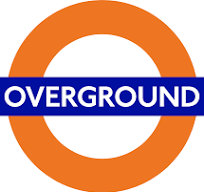



Nobody visits HOMERTON. Never mind that recent excavations in LINK ST. have exposed a building dating from the 11th or the 12th c., suggesting that the place was in existence long before its first record in 1343.
HUMBERTON or HUMMERTON was a hamlet named after a farm of a woman called HUMBURTH, and developed for about half a mile along the road on the N side of the now buried HACKNEY BROOK, within the vale formed by the brook, whose course used to begin at hamlet of CLOPTON (CLAPTON), which means hill, passed HACKNEY (by the demolished, bar the tower ST.AGUSTINE’s Church), then across marshes, and finally entering the LEA.
During medieval times, and still by 1605, this was the most populated part of the parish of Hackney. Predominantly rural, arable crops together with fruits and vegetables, were grown here, providing with food the City of London. Equally, pastures ford sheep and cattle. Meat, milk and cheese was sold at SMITHFIELD.
Small kitchen gardens, large fields behind them.
SUTTON HOUSE and TAN HOUSE provided the village with ale, brewing at a domestic scale. Fullers and tanners were unsavoury activities (urine was used to clean felt).
Landlords
Homerton became, during the Tudor period, a desirable suburb. The lands that had belonged to KNIGHTS TEMPLARS and, later to KNIGHTS HOSPITALLERS, became large estates with grand houses.
The village had a division line. The area extending to the marshes and Hackney Wick,maws the Lower. Upper Homerton, to the N., was separated from the village of Hackney by the width of the RECTORY MANOR’s HURCH FIELD, and a path led to the churchyard.
The estate, including other fields lying around the brook passed to the Tudor diplomat RALPH SADLER, in 1538. In 1560 part of 5he estate came into ownership of THOMAS SUTTON, resident at TAN HOUSE (adjacent to SUTTON HOUSE).
This land was part of his endowment to the HOSPITAL OF KING JAMES (CHARTERHOUSE) who continued to own the property until the 20th c. , building on the course of those years SUTTON PLACE (1790-1803).
Water mills
From the HIGH STREET, MARSH ROAD led to and across the marshes towards the Templar owned water powered corn mill at TEMPLE MILLS. These mills became lead works in 1795. First, lead oxide, then lead paint.
PRINCE RUPERT OF THE RHIINE (grandson of King James I) established a new water mill were an improved method of boring guns was experimented.p, in secret. However, when he died the secret method went with him and the enterprise collapsed. That happened in 1682
The marshes, prone to flooding were primarily used for grazing. In the 1770s a Roman STONE CAUSEWAY was discovered.
Non-Conformists
This was a popular place for DISSENTING ACADEMIES. In the 18th, this areas to the N. of London were more auspicious for the NON-CONFORMISTS. HOMERTON COLLEGE was one of them. Founded, imán 1768, it was based in the a High St. (destroyed in WW2). It was one of the constituent colleges of CAMBRIDGE UNIVERSITY.
The UNITARIAN GRAVEL PIT MEETING HOUSE (S. of the brook, by MONEY LANE, modern MORNING LANE, the preachers were RICHARD PRICE (supporter of American Independence, JOHN and ABIGAIL ADAMS visited him here) and JOSEPH PRIESTLEY (the discoverer of oxygen).
BP in RAM PLACE and LOWER CLAPTON RD
+wiki
Railways
The spur connecting the NORTH LONDON RAILWAY from DALSTON to STRATFORD (now a part of the MILDMAY LINE of the LO) was built in 1847, for the carriage of cold. The HACKNEY BROOK was culverted, and the extensive WATERCRESS fields S. of the HIGH ST. were lost.
The NLL was converted to passenger service in the 1880s, and that gave impulse to speculative building: the MEDIEVAL core was redeveloped. HOMERTON STA. dates from 1868.
The Hospital
In the 1860s London fell prey of fever epidemics, as typhus, scarlet fever, lung pathologies… The EASTERN FEVER HOSPITAL, now HOMERTON UNIVERSITY H. , was founded. Equally the HACKNEY HOSPITAL, within the WORKHOUSE, now part of the HACKNEY MENTAL HEALTH TRUST.
The old HACKNEY GENERAL HOSPITAL saw the birth of MARC BOLAN and RAY WINSTONE.
WELL STREET.
Originally a road connected with MARE ST. (main road leading to HACKNEY), the growth of the settlement which began from the 15th c. onwards, beside the WELL STREET FIELD (the COMMON) ended that connection.
The land was owned by the KNIGHTS HOSPITALLERS, who established a moated PILGRIM’S HOUSE -DOMICILIUM- on the N. and S.sides.
See V&A museum collection
The area was marked by the SIR JOHN CASS FOUNDATION, which established housing and schools. He was a builder and a merchant, who had escaped the GREAT PLAGUE of 1665. He became an MP.
In 1709 he founded a SCHOOL in the parish of ST. BOTOLPH ALDGATE. His foundation established here the SIR JOHN CASS SCHOOL OF ART and HALL of residence.
1730s-40s.The country was entering the industrial age. CELIA FIENNES, a resident here, but a traveller, as well provided in his DIARIES an insight into the new landscape. In the corner of WELL ST. and MARE ST. an industrial building bears her name, and sports a PLAQUE on its wall.
By 1821 lived here around 200 households. The landscaping and opening to the public of VICTORIA PARK, was a stimulus for attracting more population, and still remaining a relatively prosperous place, where shops sat side by side with ROPE and BOOTMAKERS and LEATHERWORKS.
The SOUTH HACKNEY PICTURE PALACE was established in 1913. A cinema!.
In the 20s the SHORE and the KINGSHOLD ESTATES were build. After WW2 the FRAMPTON and the GASCOYNE.
The WELL ST. MARKET. And, yes there is a TESCO, as well)
The old country lane saw the market grow and officially established in the 1850s when speculative builders were putting yellow bricks over yellow bricks… in the form of 2 storey terraces, with round arched first floor windows, peeping like eyebrows above the shop-fronts.
A working class clientele used to come to buy fruits and vegetables, and all types of food… Nowadays, big day is Saturday, when fruit and veg still at moderate price and canned or packed food at reduced prices is on offer, in around 80 stalls. This happens thanks to the market being relaunched in 2011, giving a boost to the area, an initiative of the WELL ST. TRADERS AND RESIDENTS ASSOCIATION formed only in 2010.
However this market has a great clam to fame: in 1919 JACK COHEN began trading from a stall here. A humble beginning?. A degrading job?… He was a natural salesman, though, and he was aware of the mentality and motivations of his working class neighbours. His rapport with them was excellent, and he was very admired.
As he fought in the GREAT WAR, after the ARMISTICE, he used his DEMOB money to buy NAAFINSTITUTES surplus goods, which he started to sell at cut price, with a rapid turnover. That was his secret. He made a profit from his first day here.
And before long he expanded: he had stalls in a few London markets: in HOXTON, CHATWORTH ROAD, HAMMERSMITH, the CALEDONIAN. A little empire. Well, this TESCO (TesCO) that you see now is part of a huge empire, a monument to its creator (WREN dixit). COHEN established his first TESco shop in association with his tea supplier, the merchant TE STOCWELL That JACK COHEN, born in the JEWISH community of WHITECHAPEL, became SIR JACK.
A bevy of artists and would be artists have arrived, using empty spaces as studios and pop up exhibitions.
KAREN JANSSEN’ s PROJECT SPACE GALLERY is at no.213.
Enjoy the area!.
A walk or a cycle ride to HACKNEY
ELSDALE ST
ZINC HAUS (HOUSE)
A new development of designed apartments, built around a streamlined ART DECO building. Chic kitchen, high quality dark oak flooring, clad with a sophisticated zinc finish.
A development by Bridge New Homes and Land, designed by G PAD, LONDON Architects
This was the site of a MATERNITY AND CHIKD WELFARE CLINIC, an early 20th c. experiment of social and health services.
Designed by the HACKNEY BOROUGH engineer PERCIVAL HOLT
DARNLEY ROAD
Site of the DUKE OF DEVONSHIRE PH
Can you see the name, high on the walls?. Now, converted to apartments.
Alongside CHATHAM PLACE
Have a look at
Linked pairs of Regency houses and former industrial units
Site of the BRAIDWOOD ACADEMY FOR THE DEAF AND DUMB
The first of this type in England
Think about the area where you are right now…
Site of LODDIGES NURSERY
In the 18th-19th cs., the most famous nursery garden in Europe, stood here. Where tropical plants grew and flowered for the first time outside their native rainforest. ‘I fancied myself in the Brazils’ wrote a visitor, in wonderment at the artificial tropical rainstorm inside the largest hothouse in the world.
Funny enough the commemorative plaque is now in H.MUSEUM
Welcome to Hackney
CHATHAM PLACE — MORNING LANE OUTLETS Luxury Shopping, in HACKNEY?
HACKNEY, an inner city district. Working class. Rundown Council Estates. Neglected streets, squares and gardens. Criminality. Riots (2011).
Well, all that is (almost)history. The area has been greatly regenerated, with the help of the money injected by various institutions, following the riots.
In fact, BURBERRY had established the first outlet, in the 90s, in the site of one of its factoríes, closed in 1991.
Definitely you are still off the beaten track, in (still) the less hipster side of Hackney. But think that if you had come to this area a few decades ago you would have found a barren place!.
Now, AQUACUTUM, PRINGLE, ANYA HINDMARSH, JOSEPH, NICOLE FARHI, COLOMBO, ZADIG & VOLTAIRE, MATCHES, NIKE… have taken advantage of lower property costs.
HACKNEY WALK (2016) was designed bybDAVID ADJAYE, for MANHATTAN LOFT CORPORATION.
THE BOX (2017) offers 3.000 sq.ft. of space devoted to sample sales.
HACKNEY EMPORIUM
New small business had as well the guts to open here, like RAILROAD CAFE, BREW FOR TWO (by EYLEM BINBOGA, fashion graduate by the RCART), BAR KINO…
Enjoy the initiatives of young local creative business people!
RAM PLACE
The GRAVEL PIT CHAPEL
Now AQUASCUTUM
RICHARD PRICE and JOSEPH PRIESTLEY were preachers here.
PRIESTLEY invented the carbonated water. He is honoured with a statue in BLOOMSBURY, at the ROYAL INSTITUTE OF CHEMISTRY.
First, this Non-Conformist temple became UNITARIAN. Later on, it was taken over by the CONGREGATIONALISTS.
Alongside Churchwell Path and Mehetabel Road
MEHETABEL is a Biblical name. In a land of Non-Confirmists, where the Bible is paramount, even the street-names reflect their religious world.
HOMERTON HIGH STREET
SUTTON HOUSE
Now, nicely restored, is owned by the NT.
A rare example of a TUDOR red brick house, in EAST LONDON. In fact, it was called BRYCK HOUSE!. And it’s the oldest house in East London!
B. c.1535 by RALPH SADLER, the Principal Secretary of State for HENRY VIII.
It became the dwelling of a succession of merchants and sea captains, a Huguenot weaver, a Victorian School mistress, an Edwardian clergyman….
In fact it has housed a boys school, and a girls school, and the ST.JOHN’S CHURCH INSTITUTE, or parish school. It became a CENTRE FOR FIRE WARDENS during WW2, and in the 60s it was rented by the ASTMS trade union.
Just think, though, that 50 years ago, this beautiful attraction was just one of Hackney’s numerous squats. In the 80s it was called the BLUE HOUSE, and was used as a music venue and social centre.
After eviction and a period of abandonment and disrepair , it has painstakingly restored to a state that does justice to its status!.
First, it was rescued by the SUTTON HOUSE SOCIETY (Save Sutton House campaign), who open it for the first time to the public.
The first works were completed in 1991. An art gallery was established, and as well schools and community programmes. Then it was licensed to hold marriages. A café opened. Now, exhibitions, concerts and lectures are held in the WENLOCK BARN.
Great job by the NT. And the MURAL left by the SQUATTERS in 1986 has been preserved…
Original, and rare, linen fold panelling (wood imitating folded linen or window tracery) , a Renaissance style carved stone fireplace, a Tudor window… plus 17th and 18th cs, additions, including the painted staircase, with crests of arms. A trompe-l’oeil on the frieze.
If I is true that the core of the house is original, in GEORGIAN times it suffered a number of reforms. For example it was enlarged, a storey was added, changing the type of roof, and eliminating the gables. Or sash windows instead of the mullioned ones, or a second entrance door, on the West wing.
So… what about Mr.SUTTON?.
THOMAS SUTTON, another notable of Hackney lived next door, in TAN HOUSE, which was demolished in 1806 (SUTTON PLACE was extended on its site). The name, thus, was a mis-attribution..
SUTTON PLACE
Admire the beautiful 1820s villas on the N side, and, on the S, a Georgian TERRACE, b. 1790~1806.
The street follows the course of a path through CHURCH FIELD
When in construction, lead was stolen from the roof of one of the houses, and the perpetrator, after being publicly whipped in the Village, was sent to the HOUSE OF CORRECTION, for un year.
The S side was built by CHARTERHOUSE, surveyed by WILLIAM PILKINGTON, who leased to WILLIAM COLLINS. And it occupied the site of medieval TAN HOUSE, which was used as a school.
The terrace is “soot washed”, a technique whereby the entire front was given a coat of soot, before fine white lining was applied to the darkened mortar, between bricks, giving an appearance of a finer brickwork.
Nos 1 and 2 are earlier and finer, with “barrel” bricks, wrought iron railings, and light wells. They were dwellings of wealthy merchants and gentry. A Mayor of Hackney and FERDINAND FREILIGRATH, exiled German poet lived here.
As many as 3 servants would life in the house, working in the basements, hauling coal from the cellars to the grates in the upper house. They had sitting and even sleeping quarters, and the kitchen. A range of small sheds at the rear is where washing was carried out.
The long gardens lead to the NIGHTSOIL PATH, used to collect and remove, by cart, the waste of the houses.
In 1847 the HACKNEY BROOK was culverted, becoming part of the incipient sewerage system. It is reputed to run in a large cast iron pipe through the rear gardens. The tube turns down ISABELLA RD, and joins the main network at OLD FORD.
In the 1830s, on the N, adjacent to the CHURCHYARD, the HACKNEY PRPRIETARY SCHOOL provided education for 130 boys. The MADRAS SYSTEM was used, whereby older pupils were appointed monitors, taking responsibility for the younger ones.
The school became controversial b3cause it employed many Non-Conformist teachers, and for its notorious ban on the sons of shopkeepers. By 1840, it went into decline and was amalgamated with the C of E GRAMMAR SCHOOL (on the site where the PEMBURY ESTATE is now.
The building became a private dwelling (SUTTON LODGE) until it was demolished in 1950, allowing the extension of the METAL BOX factory.
The 1820 villas to the N are accompanied by two blocks of flats, in keeping with the older buildings.
The street remained in the ownership of CHARTRRHOUSE, until well into the 20th c. METAL BOX purchased it, developing the factory and builfpding an office block. Now the core of the factory has become a private residential development, SUTTON SQUARE
At the end of the terrace 2 yards served as stables and garages. The one adjacent to SUTTON HOUSE, became a car breakers and repair garage (TAIKO AUTOS). The NT acquired it and BREAKER’S YARD was open to visitors as a garden, incorporating features commemorating its former use.
Later on one house was leased to MABYS METROPOLITAN INSTITUTION FOR BEFRIENDING YOUNG SERVANTS. It used to offer training and helped young girls from falling prey of a life prostitution.
Most of the houses fell into multiple occupancy. However, thanks to being listed (for historical reasons), they were saved.
From the 70s the area began to be gentrified, and the owners have endeavoured to restore their houses
Among the recent notable residents here, COLIN FIRTH
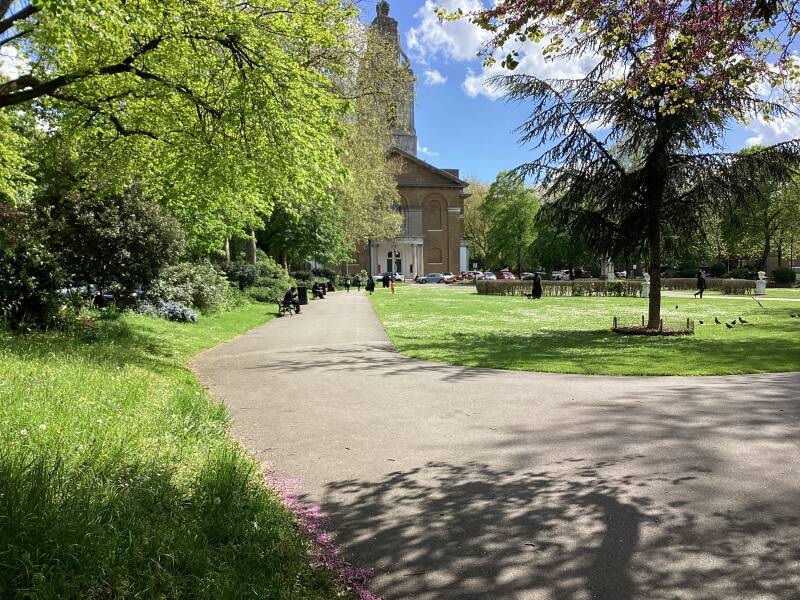
ST.JOHN AT HACKNEY, PARISH CHURCH
Magnus opus of Arch.JAMES SPILLER, friend of and very much influenced by SIR JOHN SIANE. Consecr. 1797. In order to improve acoustics he persuaded the trustees to reduce the capacity of the original project (by WILLIAM BLACKBURN) to 2.000 people.
Hackney was a huge parish (13 sq.kms, the largest of all that joined the COUNTY OF LONDON) and had growth immensely in population. The demand was therefore huge, and the old church could not cope.
Finally the body of the medieval church was knocked off, several tombs were removed to the new, bur the tower remained in place, holding the bells, as there were not enough funds to build a tower for the new church (until 1814).
In 1816 a new stained glass window behind the altar.
In the first decades of the 20th c. repairs, renovations and alterations. Electric lights. The roof, first shored up with scaffolding, was reconstructed.
Further reconstruction took place in 1955. But that year a fire started in the roof among the workmen’s tools, destroying the roof, the pews and the 1799 GEORGE PIKE organ.
A new reconstruction took place, with a reordering of the space: the HURDMAN HALL was created by inserting a partition.
The ALL SAINTS ENNISMORE GARDENS Church manual MANDER organ was installed.
Some hangings which were destined for WESTMINSTER ABBEY (for the CORONATION of QEII) were afterwards donated to ST.JOHN’s.
A new EAST WINDOW by CHRISTOPHER WEBB.
The reconsagration took place on the 24 th June, the saint’s day.
Again, in 2018 started a multi-million pound restoration project. JOHN PAWSON, a minimalist arch. who had designed the LONDON FASHION & TEXTILE MUSEUM, BERMONDSEY STREET, and ES DEVLIN, a visual artist, stage designer (stage sets for ADELE, BEYONCÉ, U2… 2012 Closing Ceremony, RIO DE JANEIRO 2016 OOGG Op. and Closing Ceremonies), reconfigured the church to an original GREEK CROSS, freeing more space for cult and music events.
The church has a working partnership with HACKNEY CH. BREW CO, whose profits help to fund work with homeless and vulnerable people.
It has become a notable music venue, with the likes of COLDPLAY, ROBBIE WILLIAMS and ED SHEERAN playing here.
And, in partnership with ST.LUKE’s HOMERTON TERRACE, HACKNEY CHURCH was formed, being designated a CIRY CENTRE RESOURCE CHURCH.
One of the trustees oversaw the subscription for planting the churchyard, HARRY SEDWICK. 129 subscribers provided enough funds to enable the plantation of avenues of elms and horse chestnuts. The SEDWICK’s TOMB commemorates his planting achievements. His son was lost in the NAPOLEONIC WARS, and is commemorated inside the church.
The MORTUARY. OPERATION MINCEMEAT

In a homely style, double fronted. A arched entrance for the hearse. Gable dormer windows B.1891. Arch THORTON GREEN. Includes rooms for a CORONER COURT.
Not a landmark of London. Nobody comes to see a mortuary… Why Should they?
MINCEMEAT?. A WORLD WAR 2 OPERSTION. A brainchild of IAN FLEMING according to some. In order to deceive Nazi Germany about the whereabouts of the landings in Europe, in 1942.
In charge of painstakingly creating a a back credible story, 2 MI5 officers: CHARLES CHOLMONDLEY and EWEN MONTAGUE.
A suitable body had to be found. A body of a vagrant who had commited suicide was laying in ST.PANCRAS HOSPITAL. MI5 got hold of him and brought it HERE, where it he lay for 3 months on ice. Meanwhile, the security services had time to create a fictitious character, an “OFFICER”, “MAJOR WILLIAM MARTIN”, who had to be planted with a fake letter, fake documents and fake private parafernalia. It would be dropped out to sea off the Spanish coast… The most important was the “letter” that the “Major” carried in his bag: a military communication stating that an ALLIED INVASION of GREECE and SARDINIA would be carried out, from the North of Africa. Nazi Germany believed the content of the letter.
The invasion of Sicily opened the way for the Allies to occupy Italy… And the rest, as they said, is history,
The route takes you either Southwards, to MARE ST. and the civic centre of the village and that of the modern district or Northwards, towards CLAPTON PARK and the LEA VALLEY
Towards MARE STREET, the town commercial and civic centre
ST.AGUSTINE’s Church TOWER
That is the only remaining part of the 16th c. parish church, which had replaced the one founded by the KNIGHTS OF ST.JOHN, in the 13th c. In medieval times, the parish covered the whole area of the current LB.
The parapet and the diagonal buttresses have been restored. And the 16th c. turret-clock.
The for
The faced clock did not appear until 1872, thought, after an appeal was launched.
As a symbol of Hackney it appears in the coat of arms of the Borough, in the masthead of the HACKNEY GAZETTE and in, in the Great War, the badge of the 10th (Hackney) Battalion of the London Regimentt.
The pop. was growing in the 18th. Galleries added. VESTRY petitioned PARLIAMENT permission to rebuild in an adjacent site to the N. In 1798, the old church demolished, some of the memorials and graves were transferred to ST.JOHN’s. THOMAS SUTTON entrails amongst them.
Finally in 1894 the 8 bells were relocated.
The cornerstones to the E of the tower were preserved, and the tower itself was used as a mortuary and as tool store
From the 1980s it has been opened up for art exhibitions, and even the roof can be visited, after climbing the winding stairway.

THE OLD TOWN HALL
You are now in MARE STREET, core of the old parish. The old commercial and civic centre.
Built in 1802, to provide a meeting place for the VESTRY COMMITTEE, the authority. Vestrymen were elected by wards.
In England, parishes, in fact, provided a framework for both civil (administrative) and ecclesiastical functions. During the 19th c. as population was growing, ecclesiastical parishes were subdivided (churches were built) to better serve the needs of the pop.
Between 1855 and 1894, the HACKNEY DISTRICT BOARD OF WORKS, which administered as well STOKE NEWINGTON until separation in 1893, sat here, as well.
Bank, betting shop and pub have been the successive uses of the building from the 1970s.

If you decide to linger alongside a stretch of the village street looking MARE ST., Northwards, the most interesting buildings are
No.366
No.389
No.397
And, if you explore BRETT RD. you will find a first:
BRETT MANOR



Please, let that the nearest DOCKING STATIONS ARE in LONDON FIEDS and N. of VICTORIA PARK
LO HACKNEY CENTRAL. MILDMAY LINE



Alongside MARE STREET, Southwards
See, in AMHURST ROAD, next to the entrance to the LO HACKNEY CENTRAL Sta
Site of E.GIBBONS, FURNITURE STORE
SYLVESTER HOUSE
THE OLD SHIP PH

THE HACKNEY EMPIRE THEATRE
Designed by the most famous Victorian theatre arch. FRANK MATCHAM, it opened in 1901, as a MUSIC HALL, later a VARIETY theatre. The ROCOCO auditorium, and reputed for its fine acoustics, is a spectacle of red and gold, splendorous. Gothic masks, golden cherubs…a spectacle of red and gold. Variety means Flamenco dancing, fire eating, Opera, comical sketches… in the same show.
CHAPLIN, WC FIELDS, LITTLE TICH, MARIE LLOYD, LOUIS AMSTRONG…
With the advent of cinema and television it went into decline. It hosted TV programmes, and even became a bingo for 25 y.
A grup of artists and local people formed SAVING HACKNEY EMPIRE, a group that fought with determination,to save it, and the area’s theatre culture.
Home to NEW VARIETY, a modern take on cabaret and comedy, it has acted as a forum for young talent (JULIAN CLARY, HARRY ENFIELD)
MARE STREET. It must be about horses, must not it?


Yes, you are standing (or sitting down, in a café) in or near MARE STREET. And you come up with the idea that the origin of this street name is related to the female of the horse. Well, no… this was an OLD ENGLISH word for boundary (with the parish of STEPNEY). Or, it might be, the word MERE, meaning lake, pond, wetland… Now you know. But…
What about the name HACKNEY?. Old forms are HACKENEYE, HACQUENYE, HAKNEY, HAMENEYE.
That EY, EYE, with certainty, means island or an unaccessible area surrounded by water. HAKA’s island?. Remember, rivers and marshes are or were around. A in Saxon times a notable person of tribe would give their name to a place (WAPPING).
However, if the river had a bend (and the LEA has many of them), shaped a a HOOK -HACA- and island (EY) was on that bend (HACA)?.
Now, back to the horses. The HACKNEY HORSE was a breed developed in NORFOLK, in the 14th c. Curiously enough, that breeding intended to produce horses ideal for carriage driving, that is, with good stamina, arable of trotting at light speed and for extended periods of time.
I seems that sometime in history, HACKNEY supplied this bread of horses, and became famous for so. This means that the village name became the name of a type of horse, and not only in Englis!.
In Old French it became HAQUE, and from it, it passed to other langauges
In Old Spanish HACA, then JACA. A correct name is JACA NAVARRA.
In Sardinian .
In Catalan of Alguer, Sardinia (It. Alghero) is (H)ACA.
To recapitulate: the MARE ST. is not originated in anything related to a horse. But HACKNEY has originated the name of a type of horse, and in a few languages…
What if now we talk about the LONDON BLACK CABS, the famous taxis, oficially called HACKNEY CARRIAGE OFFICE?.
Some expert historians suggest that there is a link between carriages and horses. Remember that HACKNEY HORSES were bred for driving carriages. Problem solved.
However the American Hackney Horse Society favours an alternative etymology stemming from the French word haquenée—a horse of medium size recommended for lady riders—which was brought to England with the Norman Conquest and became fully assimilated into the English language by the start of the 14th century. The word became associated with an ambling horse, usually for hire.
Do Newyorkers call HACKS to taxis and taxi drivers. Or, do they say HACKSTAND, and HACKLINCENSE?.
Does BOSTON’ s POLICE DEPARTMENT, has a HACKNEY CARRIAGE UNIT, issuing HC MEDALLIONS?.
THE LONDON BOROUGH OF HACKNEY
WARM SHORES. Artwork by THOMAS J PRICE
From medieval village to becoming“the University of feminine arts” then and London working class, industrial suburb, and ending up being touristic destination
The current LONDON BOROUGH OF HACKNEY stretches from the, I would say, thoroughly EAST END districts of HOXTON, HAGGERSTON and DALSTON, in the S. to the N. London suburbs of STOKE NEWINGTON and STANFORD HILL.
Now, you are in the centre, where OLD VILLAGE that gives name to the BOROUGH: HACKNEY. In a sense this was already the core of the area, as the main church, the only parish in medieval times was ST. AGUSTINE-ST.JOHN.
Mostly working class, since the INDUSTRIAL REVOLUTION, is no wonder that you find in the borough a huge ethnic diversity: the largest AFRO-CARIBBEAN community, after BRIXTON, a sizeable population ORTHODOX JEWISH, and even a greater number of TURKISH and KURDISH people. Without forgetting the small community of VIETNAMESE and LAOSIANS.
Only a 36% of the population is WHITE BRITISH. A further 18% is Irish and European. 7% are from Indian Subcontinent.
And no wonder that the MP who represents the district is LABOUR. For long years, the FIRST BLACK IN PARLIAMENT, represented the CONSTITUENCY : DIANNE ABBOT. And the COUNCIL was in the hands of the LOONY LEFT, following the terminology used by the THATCHERITE press.
The truth is that, to the West of Hackney, lied traditionally more affluent and genteel area
From Tudor times, around the quiet country villages to the North, rich merchants of London had built their second residences, far away of hullabaloo of the City. King HENRY VIII had as well a dwelling here (keeping in mind that some lands belonging to the KNIGHTS OF ST.JOHN became CROWN property after the DISSOLUTION).
In the 17th c. the locality had a reputation for having a few academic establishments, dedicated to girls (from those wealthy families, of course). Hackney received the accolade that you have incredously read on the title above.
SAMUEL PEPPYS, omnipresent and connoisseur, advised in his diary to come here, visit the church and… admire the girls!.
Some areas of the borough are marshy, and susceptible to flooding, as rivers have their course across the area, like the HACKNEY BROOK and the VALLEY of the RIVER LEA. The first has been culverted, the second is still important, but historically it separated tribes or nations (Catuvellani from Trinivantis, Middle-Saxons from East Saxons), then counties (MIDDLESEX - ESSEX) later on boroughs (HARINGEY, HACKNEY and TOWER HAMLETS - WALTHAM FOREST and NEWHAM).
Some parts of the LEA VALLEY became heavily industrialised, other were covered with reservoirs and water treatment plants. Now, you are going to find natural spaces, for you to enjoy.
However, the district was still industrial and working class in the last century, when the process of gentrification began.
By the way, right wingers laughted at the leftist Council when, in the 1990s, had the idea of appointing a “TOURIST OFFICER”, and sign posts started appearing since, pointing at “TOURIST ATTRACTIONS”. I bet the area is going to repay your visit. And right wingers were wrong.

HACKNEY TOWN HALL
The site selected for current facility, the third town hall, was just to the west of the second town hall on land which had previously been occupied by residential properties.[6] The foundation stone was laid by the Minister of Health, Sir Hilton Young, on 22 October 1934.[7] It was designed by Lanchester and Lodge in the Art Deco style and officially opened by the Chairman of London County Council, Lord Snell, on 3 July 1937.[8] The design involved a symmetrical main frontage with thirteen bays facing onto Mare Street; the central section of five bays featured a doorway flanked by windows on either side on the ground floor; there were five round headed widows leading onto a balcony on the first floor with a clock and the borough coat of arms above.[1] The principal rooms were the council chamber, the mayor's parlour, the members' room and an assembly hall running along the rear of the building.[1]
The whole paragraph has been taken from the WIKIPEDIA
The LB of HACKNEY COAT OF ARMS
ST. AGUSTINE’s TOWER, standing in a small green hill, in fact representing an ISLAND (remember the ethymology of the name Hackney, HACA’S ISLAND).
The MALTESE CROSS, representing the past owners of the Manor, TEMPLARS and HOSPITALLERS
The OAK TREES represent STOKE NEWINGTON. The red coloured acorns are visible
The blue bordure of the shield represents WAVES , that the rivers and canals
The 3 BELLS represent SHOREDITCH, more precisely the bells of ST.LRONARD’s Church, known for the nursery rhyme ORANGES AND LEMOS. The number of bells alludes to the 3 METROPOLITAN BOROUGH merged to form the current LONDON BOROUGH

LEARNING CENTRE, PUBLIC LIBRARY & HACKNEY MUSEUM. And a café, a usual
In the library, sometimes, you might find interesting information leaflets, brochures or maps. Why not relaxing yourself a bit and read the papers… Or you can buy a used book on sale!.
The local museum explains the history and the present of the district in a way easy to understand, very visual. You will see it in less than an hour. At the desk, on sale, locally themed books.

HACKNEY PICTURE HOUSE
Originally Hackney Central Library and later a concert venue, this landmark building was converted into a cinema in 2011, creating some stunning interior spaces.
Picturehouse Cinemas and architects Panter Hudspith transformed the building into a six-screen venue with a restaurant and two bars. The Picturehouse touch has brought a mix of modern industrial glamour and urban cool to this Hackney Cinema, which is overtly bold and brutalist in construction. It's a fun, funky and impressive place to hang out. Citation from PICTURE HOUSES
Site of the WOMEN’S SOCIAL & RESCUE WORK FOR THE SALVATION ARMY HQ
VALETTA HOUSE (or BUILDINGS)
Valette Street was one of the earliest examples of publicly owned houses in Hackney. Built by the LCC in 1904 on the site of the former Jerusalem Square and Passage it housed skilled working class tenants and was built partly in respnse to an appeal by the Trades Council to relieve the high employment of building workers in the East End. Citation from Flickr
Shopping, eating and drinking
MARE STREET is lined with stores, supermarkets, shops, convenience stores, charity shops and eateries.
Remember the OLD SHIP PH?. What about the COCK TAVERN?. As usual, my favourite is a JD WETHERSPOON, BAXTER’S COURT.
The HACKNEY TAP, located in the old town hall
The CROWN PH is near the church, al the top end of village like MARE STREET.
You have PIZZA EXPRESS and the BRITANNIA, a greasy spoon.
PRET A MANGER and COSTA are in AMHURST RD.
Fancy staying here?
And now on, Southwards, to BROADWAY MARKET
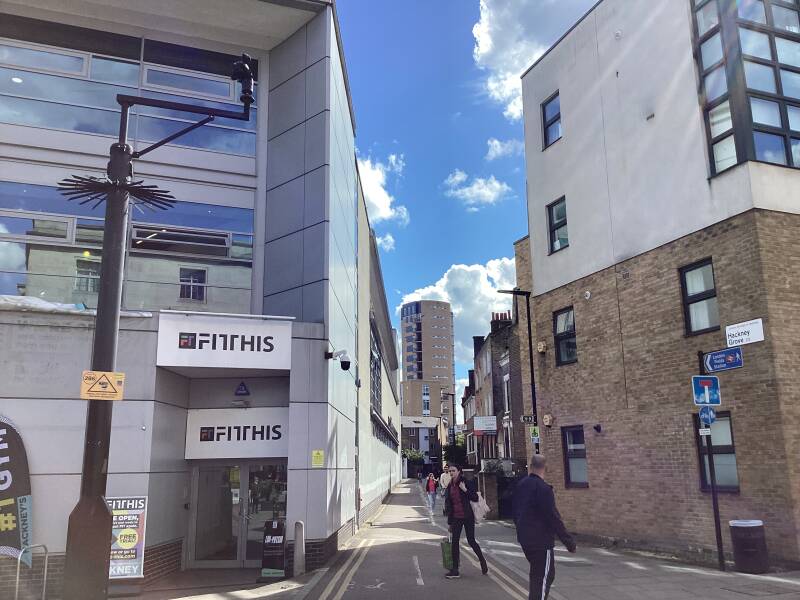
Alongside the BLACK PATH (officially HACKNEY GROVE)
Instead, Nortwards: To the LEA VALLEY
Along LOWER CLAPTON ROAD
THE CROWN PH, and GUESTHOUSE

After church and churchyard
CLAPTON SQUARE
A green space where used to be fields of the MANOR of the TYSSEN family, in fact the second largest garden square in the borough.
Around the garden 2 sides of terraces of Georgian houses, tall, partly stone-dressed. They were the homes of senior merchants, officers, financial brokers… pretty upmarket!.
5 storeys, with leaded fan lights, pilasters, upper cornices (white ledge), porticoes, sash windows, ornamental cast iron balconies, columns and porches. Some frontages are adorned with trained ivy or wisteria.
In the late 19th. Some houses were replaced. And the RECTORY moved here in 2006. The East side had to be rebuilt after WW2.
The garden contains shrubs, trees, and historic stone ornaments. The DRINKING FOUNTAIN was erected in 1894, as a gift to the residents by HOWARD MORLEY.
Figures who have resided in the square are:
Jewish writer GRACE AGUILAR
THEODORE ROTHSTEIN who, in 1920, was ambassador to the UK, and later on had other positions. He had settled in the country since the 1890s. His friend LENIN visited here. He died in 1953. Son ANDREW became a prominent member of the CPGB.
In no.5, THOMAS BRIGGS, a chief clerk of ROSARTS CHRTIS BANK. On. The 9 July 1864 he became the first person murdered on a train, in Britain.
Former POLICE STATION
Housing offices, cells and accommodation this building was in operation until very recently. It was designed by arch. JOHN DIXON BUTLER for the MET, as so many other stations.
Slate mansard roof, with dormers. Attics and semi-basements. Attached buildings.
Door case, arched hood, console brackets on pedestal.
Three light-canted bay windows, narrow architraves windows with small lights above.
Stone-bracketed eaves cornice. Narrow lancet. Return wall gables form chimneys.
Chimney breasts, round arched recesses, stone keystones and vousoirs.
Recessed sashs.
Chimneys continue through apex of gables as separate.
Nos.14-16 GEORGIAN semi-detached pair, with semi-basement and raised GF. Third floor, added later, with mansard roof. Shallow dormer windows.
Stucco detailing. String course. Cornice to parapet.
The flat brick arches to windows are original, it now are covered in stucco, expressed as lintels.
No.14 has a repaired and altered projecting porch, circular corner columns. Iron balustrade and handrail.
No.16 had a 2 bay wide single storey extension built later, forming a shop unit, filling the front garden.
The STRAND BUILDINGS were originally the HACKNEY ELECTRICITY DEMONSTRATION HALLS and OFFICES
Art Deco, with a symmetrical PALLADIAN façade. A set back 3 bay arcaded main block, with a projecting GF shop front. Wings.
Heavy cornices at parapet height,
Façade clad in PORTLAND stone ash lar , or pre-cast corner.
The stylised details are DECO: Russification, ornamental pilasters, support brackets.
Above cornice, the parapet containing the name.
Steel windows








KING’S HALL & PUBLIC BATHS, now LEISURE CENTRE
- 1894-97. Arch. EDWARD HARNOR, with FREDERICKPINCHES
Portland stone, in a RENNAISSANCE style, with Ionic doorcases.The front was the administration block. The central spine housed the changing rooms. The main areas were either side of the pool to the left, now a sports hall, and the main pool is to the right.
The upper floor housed accommodation, served by a separate entrance.
Site of PH. THE ELEPHANT’S HEAD, became THE FITZGERALD
Late Victorian. Red brick, moulded brick string course and window details. Ornamental plaster panels. Plater pediment with an elephant’s head medallion. The GF front is original, and the interior conserves original features
Nos.19-35 The front gardens of the houses, subsequently built over to form shops, when the area was becoming a shopping district, in Victoria’s times. Good surviving parapet to roof line
A diversion Westwards. is possible from CLAPTON SQUARE towards STOKE NEWINGTON via HACKNEY DOWNS PARK
On the map BRIGHTON ROAD, before joining the Northwards route to STOKE NEWINGTON from DE BEAUVOIR and DALSTON-KINGSLAND


HACKNEY DOWNS
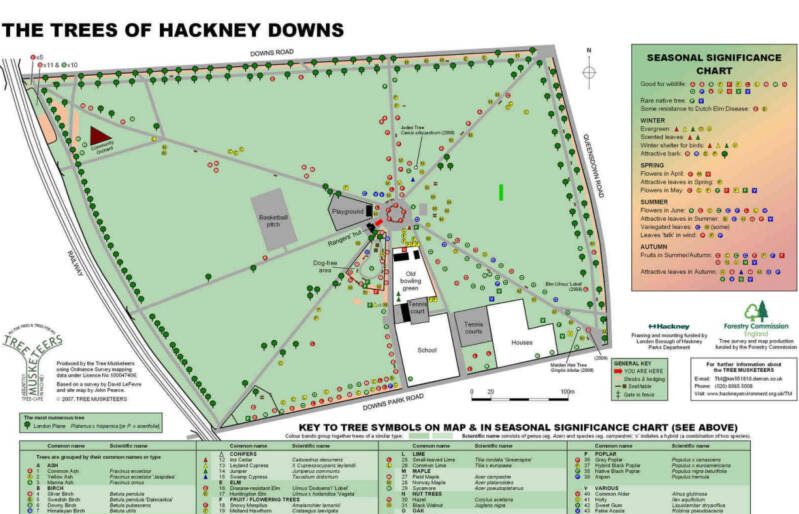
But your route continues on Eastwards
Off CLAPTON SQUARE: CLAPTON PASSAGE
HOLLY VILLAS
9 two storeys plus basement. The end building 3 storeys. In London stock brick, slate roof.
Ornamental stucco, arched windows with column and capital details.
In the GF, projecting segmental bays with lead roof.
Sharp-pitched gables at roof level. Brick quoin detailing.
No.22 is double fronted with vehicle entrance, arched GF. Some decorative ridge tiles remaining.
At the corner with the main road, you can see two plaques:
JOSHUA WATSON’ home
Philantropist, educationalist, Church layman. And wine merchant!.
JOSEPH PRIESTLEY’s home.
Supporter of the FR1789, he had hounded by the mob out of his home and laboratory, in BIRMINGHAM. He was invited to come to HACKNEY to take up his post of Unitarian Minister at the OLD GRAVEL PIT CHAPEL, in CHATHAM PLACE (which in 1809 was transferred to PARADISE PLACE).
He had many friends amongst the Hackney Dissidents,
In 1794 he emigrated to AMERICA, fearing a repeat of his family’s persecution,.
To the rear of JP’s home, in a cottage, lived
LOUISA PERINA COURTAULD
She was a designer of gold plate, widow of a silversmith. They were HUGUENOTS. Their son was SAMUEL COURTAULD Jr, founder of the COURTAULD dynasty of silk and artificial fibre manufacturers; they made RAYON, artificial fibre made from natural sources. Another descendant, SAMUEL CURTAULD, as well, founded the INSTITUTE OF ART bearing that name.
Alongside the LOWER CLAPTON ROAD
Pointed on the map MOTHERS’SQUARE

The ROUND CHAPEL
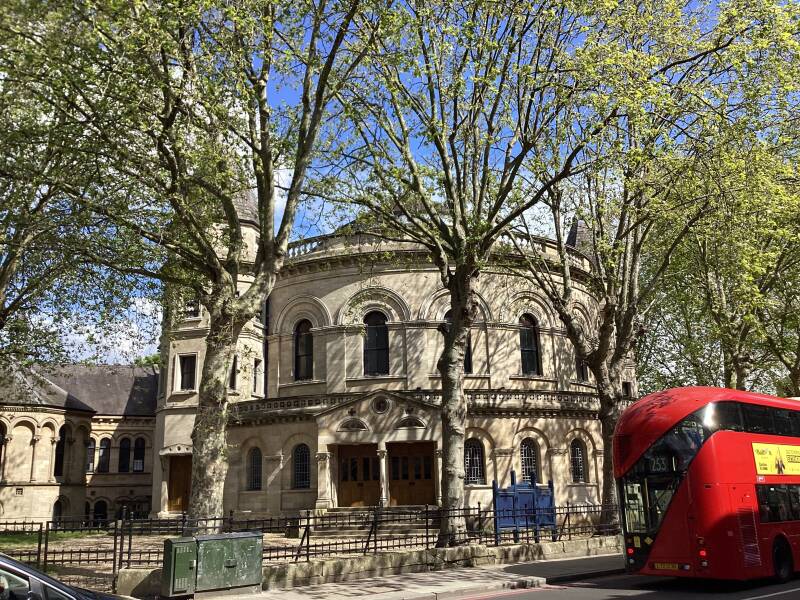
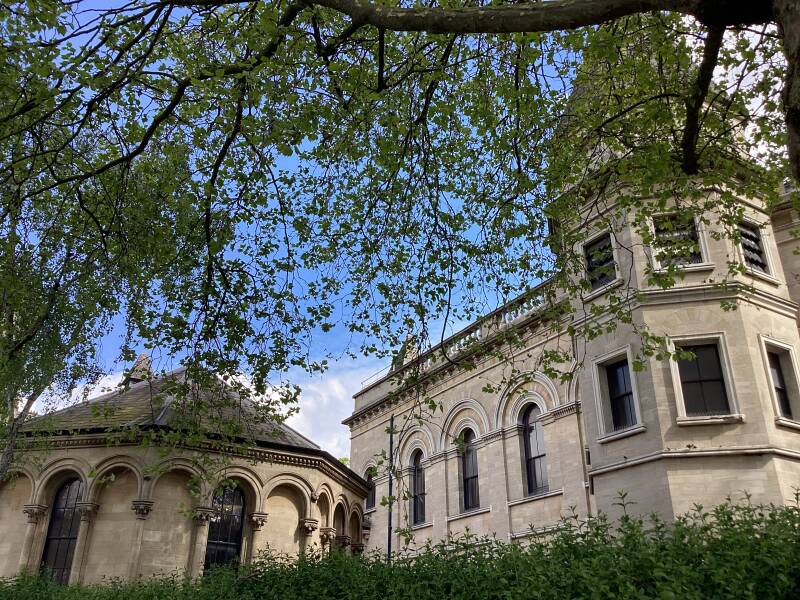


Opened here in 1871, but of more modest origins… In 1804, a Non-Conformist CONGREGATIONAL chapel was established at MORNING LANE, the OLD GRAVEL PIT CHAPEL, in fact a breakaway from the RAM’S CHAPEL, HOMERTON. From the 17th c. groupings and regroupings of Dissident churches were common in East London. This was a centre of the Non-Conformist movement, with s its cemeteries, academies, famous figures, like D. DEFOE and ISAAC WATTS…
The pop. had expanded: from 35.000 to 115.000, and then 230.000 in 1901. That needed an intense house building, with the creation of new suburbs (BRICKS and MORTAR!). CLAPTON PARK was born.
By 1868, the congregation of the OLD GRAVEL OIT had quadrupled, and they decided to build a new chapel: the CLAPTON PARK CHAPEL, which became one of the most important, growing in congregation volume and in the number of activities.
Amazing interior shape!. With cast iron columns, which created controversy, as, up to then, they were only used in railway stations and music hall theatres, being considered improper of a religious cult space.
From the last decade of the 19th c., the neighbourhood changed its composition and the congregation sunk.
Now, after years run down it is a Grade II* listed building (only four per cent of buildings are) and only the OLD SCHOOL ROOMS are kept by the UNITED REFORMED Church. It is managed as an arts and community venue.


Lovely muffins and coffee


Pawn shop
You can link this Northwards route with the Southwards route from the UPPER CLAPTON area (CLAPTON COMMON, after STAMFORD HILL)
Alongside LOWER CLAPTON ROAD
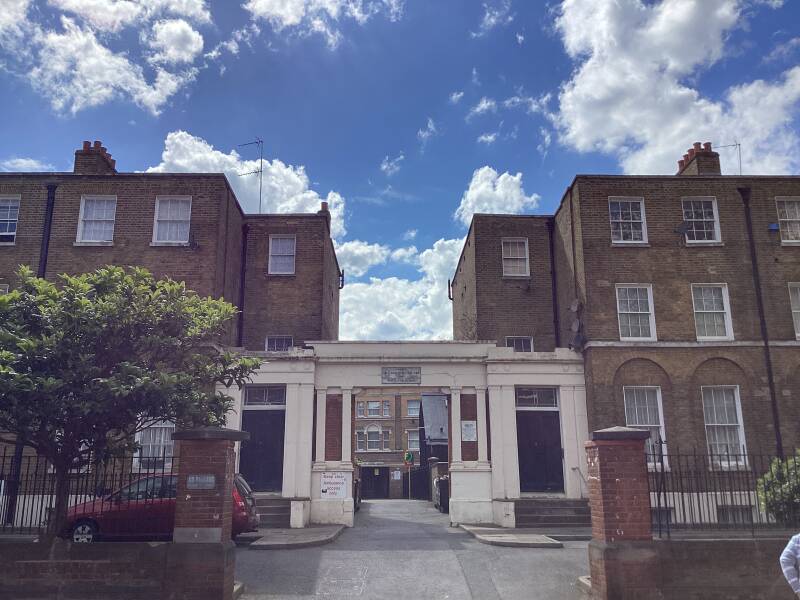

MAITLAND PLACE.
Site of HOSPITAL FOR UNMARRIED MOTHERS
Semi-detached substantial villas b.c.1804, and used as nurses quarters and offices of the hospital f. by the SALV.AR. in 1884
At the rear, modern MOTHERS’ SQUARE lies on the site of buildings demolished in 1992. The new buildings were designed by arch. HUNT THOMPSON for the HOUSING ASSOCIATION, in a Classical style, delivering imitating Victorian Hackney. A central pergola reduces the effect of on-street parking. It earned the CIVIC TRUST AWARD.
ROWHILL ROAD






Off LOWER CLAPTON RD., in LINSCOTT RD.
Site of the LONDON ORPHANS ASYLUM, now CLAPTON GIRLS ACADEMY.
B.1826, designed by arch. WS INMAN
A substantial Classic portico is the only remnants of the original building: in fact, the chapel and two colonnades that led to the dormitories.
The Asylum was vacated after the cholera epidemics of the 1860s, and the SALVATION ARMY took over, opening the building, in 1871, as the CONGRESS HALL. In 1937 it was used as a refugee centre housing 400 BASQUE children. According to BRIGADIER J MARTIN’s report, the kids were very undisciplined, the boys climbing over the roof “like little monkeys”. “For the most part they have no sense of religion or use for the church. They seem to have Communist sentiment”.
Nos.156-162. BISHOP’S WOOD ALMSHOUSES
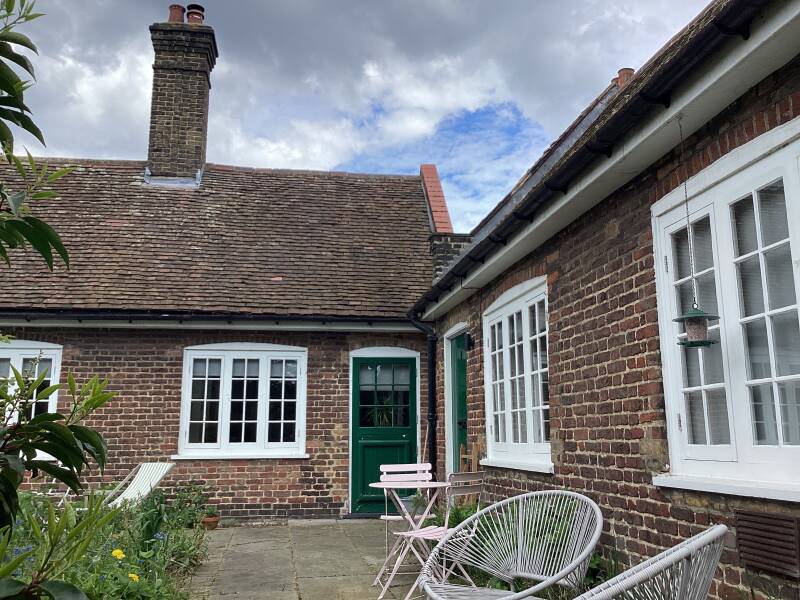


Site of the GAVILLERS GARDENS
Brothers Augustine and William Gaviller lived at 183 Lower Clapton Road at the beginning of the 20th century. The Gaviller family had a long association with the sugar-refining business and the occupation of Augustine Gaviller was listed as West India Merchant. His brother William was a keen gardener and shortly before his death in 1912 he commissioned a professional photographer to record the garden and the principal rooms of the house. These are the earliest colour photographs of any Hackney subject in existence. The photographs of the Gaviller garden demonstrate an enthusiasm for exotic plants, including the Giant Hogweed. Although an impressive sight when fully grown, Giant Hogweed is invasive and potentially harmful as chemicals in the sap can cause skin blistering and permanent scarring. It is thought that that the Gavillers' fondness for this plant may have resulted in its eventual migration to the banks of the River Lea.
CLAPTON POND
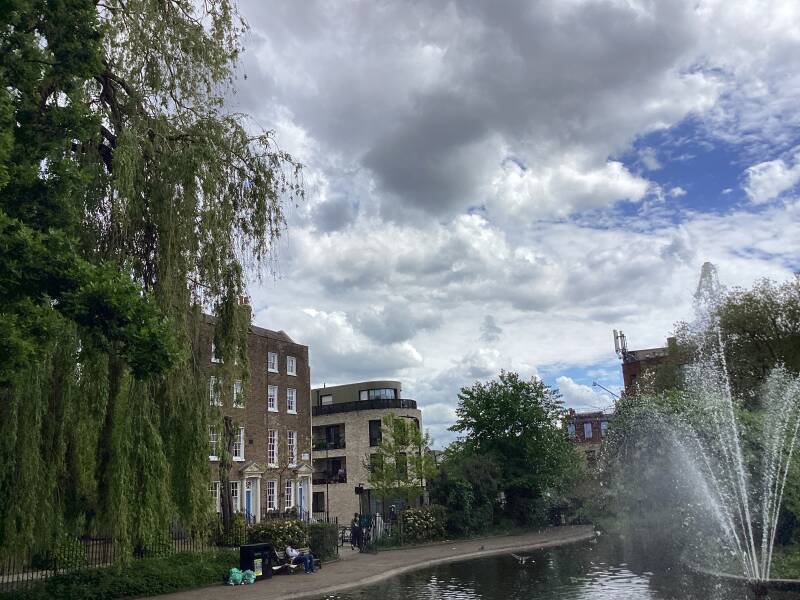
Said to be dug out during the early 1600s, by the HACKNEY WATER COMPANY, as a reservoir, for the purpose of domestic water supply and watering hole for livestock and horses.
By the 19th the pond laid out neglected, and finally plans were drawn up to drain it and fill it in. In 1898 the HACKNEY VESTRY purchased it and converted it into a public garden, landscaped with flower beds and new trees to a pattern that largely survives to the present day.


POND HOUSE
B. at the beginning of the 19th c., when CLAPTON had become a fashionable residential area, it constitutes a fine example of GEORGIAN architecture. In more modern times, it fell into neglect, an EH included it into its HERITAGE AT RISK REGISTER. At the beginning of our century, ONE HOUSING GROUP acquired it, and restored its features, like the bow window to the drawing room overlooking the gardens on the rear. In fact, the garden had been huge, when the house was built, with a wall of fruit trees, running for 640 feet, and including a melon garden, a seed house and a tool house. Two cows were kept to provide milk to the family. MAIDENWELL RD. occupies part of the garden now
Still alongside the LOWER CLAPTON ROAD
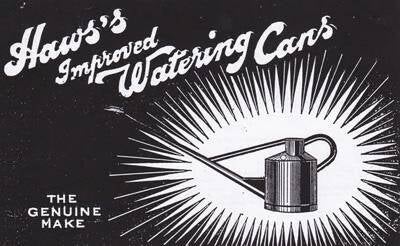
Site of an INVENTION!: J.HAWS WATERING CAN FACTORY
Our name comes from our founder John Haws, the inventor of the watering can design that we still produce, virtually unchanged to this day. Originally from Clapton in London, John was by his own account quite an unsuccessful gardener. But in 1884, while struggling to grow vanilla during his British colonial service in Mauritius, he set about designing his own watering can to improve his gardening fortunes.
In 1886 he secured the patent, established the Haws company, and described his unique design as follows: "This new invention forms a watering pot that is much easier to carry and tip, and at the same time being much cleaner, and more adapted for use than any other put before the public." The history of the company, transcribed up to here, continues…

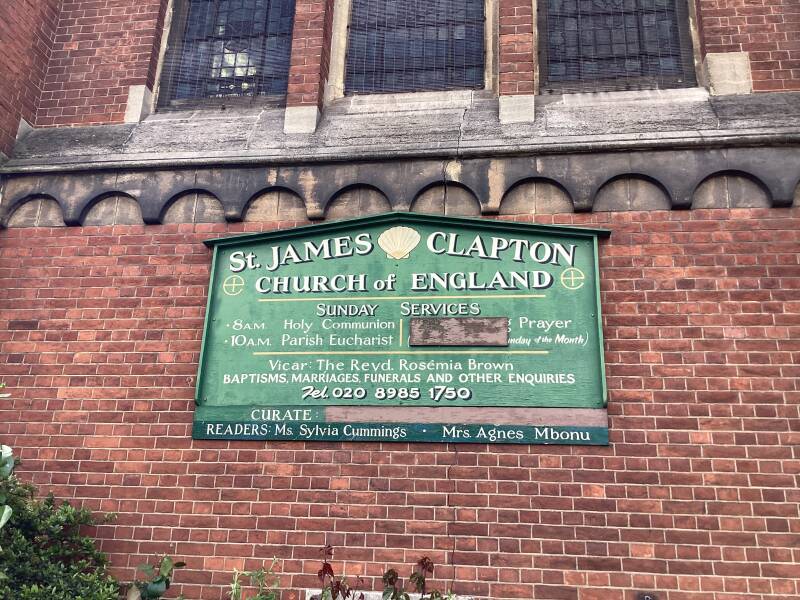
ST.JAMES’s Church
Former CLAPTON CINEMATOGRAPH THEATRE
THE CLAPTON HART PH
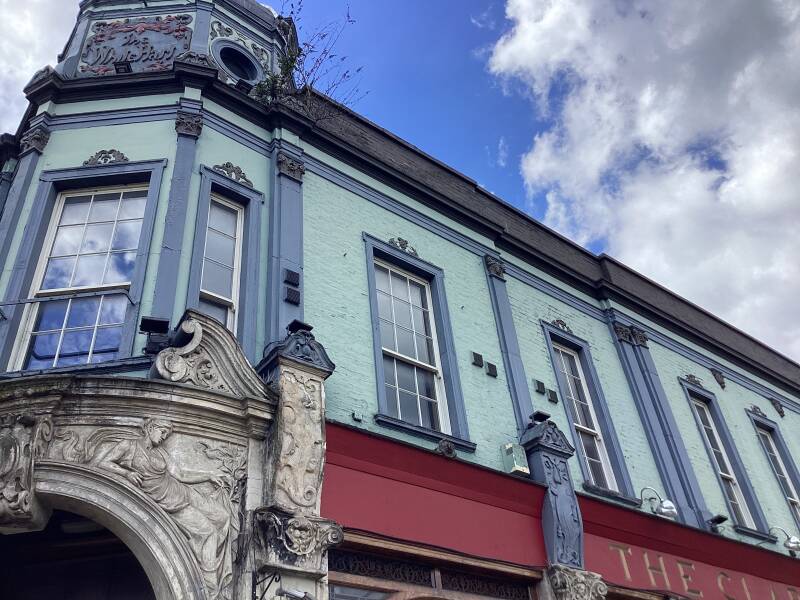

THISTLEWAIT ROAD
HAROLD PINTER birthplace
FIRST SYNAGOGUE in HACKNEY
Now, you are very close to the wide roundabout and to LEA BRIDGE ROAD.
To the East, the LEA VALLEY and the LEYTON.
To the North, UPPER CLAPTON. The school between BROOKE RD. and KENNINGHALL RD. occupies the site of BROOKE HOUSE
The MADINA MASJID, LEA BRIDGE RD, pointed out in the map

Now, the route takes you to the West Bank of the RIVER LEA. The district is CLAPTON PARK
After CLAPTON SQ. and PASSAGE, alongside POWERSCROFT ROAD
Not this club. The UNITED SERVICE CLUB is in ST.JAMES’. The ver DUKE OF WELLINGTON, of WATERLOO fame, was a member, as many other high ranking officers of the British army in REGENCY times
No.69 Site of HACKNEY UNITED SERVICES CLUB LTD
B. in EDWARDIAN times as an association of ex-servicemen of WW1.
2 storeys + attic continued within the slated mansard roof. Tripartite window, stone mullions and surrounds.
Brick dentil cornice, painted string course.
Here, in 1925, says the Plaque “the old contemptibles Timon was born”, “to the Glory of God”, “to the imperishable memory of Captain French’s contemptible little army”.
It refers to the British FIRST EXPEDITIONARY FORCE sent to the WEST FRONT, in Aug. 1914. KAISER WILHELM of GERMANY was dismissive of the force and issued the note e stating: “exterminate the treacherous English and walk over General French’s little contemptible army”.
You are now in CLAPTON PARK

I suggest that you walk or cycle until you reach MILLFIELD ROAD, but you can shortcut the route directly to CHATSWORTH ROAD and enjoy a cup of coffee or a meal in one of its many eateries.
In 1749 was opened the HACKNEY CUT, the canal. To its East, a vast marshy wilderness, to its West an empty area. Land, for the most part, belonging to the the HACKNEY HOUSE ESTATE.
HACKNEY HOUSE was built, 1723-32, for STAMP BROOKBANK, MP and Governor of the BANK OF ENGLAND. The house itself was where the CLAPTON GIRLS ACADEMY now is, that is same the site of the LONDON ORPHANS ASYLUM.
From the 1860s, the LONDON AND SUBURBAN LAND BUILDING COMPANY, built up the district, where hitherto market gardens and watercress beds were tended. And they came up with a name for the it. Not very original, but there you are.
First CHATSWORTH ROAD was laid out, on the site of a long field path, and the space in-between with LOWER CLAPTON RD. began to be filled vital streets of terraced houses. They had thought about everything: Shopping, entertainment (the CLAPTON PARK THEATRE, GLENARM RD.)), and… the TOWER BREWERY (ASHENDEN RD.).
By the 1880s a dense network of streets stretched all the way across to the HACKNEY CUT.
To the South, a remnant of the HACKNEY MARSH was still present: DAUBENEY FIELDS or GREEN.
Around the turn of the century the area South of REDWALD RD. was laid out.
Schools had to be build: RUSHMORE ROAD, DAUBENEY RD, MANDEVILLE ST. And CofE churches: ALL SAINTS and ALL SOULS (succeeded by the RISEN CHRIST & ALL SOULS).
In 1936-38 the LCC built the KINGSMEAD ESTATE, on a site previously occupied by the NATIONAL PROJECT SOCIEY and the KINGSMEAD SCHOOL. People moved here when they were displaced by slum clearances in BETHNAL GREEN.
The CP METHODIST Church was b. in 1958. RC ST.JUDE, in 1965, in BLURTON RD., on the site of 5he Methodist Chapel.
Victorian terraces were demolished, and the CHATSWORTH ESTATE built. The LCC’s BEVAN ESTATE included a 12 storey tower. The towers of the CLAPTON PARK ESTATE have been demolished, bar one.
LANDMARK HEIGHTS was built by private developers, on the site of the Council’s SUDBURY COURT.
The conditions of the KINGSMEAD deteriorated. “A blighted labyrinth, “where a paedophile ring operated, resulting in the abuse and murder of a teenager, “a council gardener holding satanic masses and murdered the 5 years old son of his girlfriend, “a police unable and/unwilling to curb the crime wave… That was CLAPTON PARK at the beginning of the 21rst c.
Now, the estate has improved, managed by SANCTUARY HOUSING, with the community support of HALL MARSH PARTNERSHIP.
And the terraced streets commenced a process of gentrification…
Now, enjoy that gentrification!. CHATSWORTH ROAD & BROOKSBY WALK
Pointed on the map, CHATS PLACE

HOMMERTON LO Station

This became the core of the Victorian district. Shops, eateries, and street market. Nothing has changed , you will think, let us go and enjoy… Bur now that you are here let me tell you that even myself I wonder sometimes how things change. II am telling you that 20 years ago. I would not have written this article. The state of things was quite different… but they were starting to change.
Enjoy the SUNDAY MARKET… if you are coming on a Sunday!. Otherwise, browse through the place, explore the shops and cafés, North to South, towards HOMERTON, where the street is, in fact, called BROOKSBY’S WALK
First, I leave you with that LADY IN LONDON who writes so well, and then a will continue relating interesting places worth having a look, before you head North again, towards MILLFIELDS and then the LEE NAVIGATION.
THE CASTLE CINEMA. Art Deco
CHATS PLACE
You are now entering MILLFIELDS SOUTH
Site of HACKNEY POWER STATION “A” & “B”. WASTE DESTRUCTOR
MILLFIELDS DESINFECTING STATION
MANDEVILLE COMMUNITY PRIMARY SCHOOL




